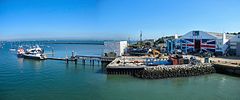East Cowes, Isle of Wight
| East Cowes | |
|---|---|
 East Cowes seafront, showing the Columbine Yard building with its Union Flag doors. |
|
| East Cowes shown within the Isle of Wight | |
| Area | 5.0924 km2 (1.9662 sq mi) |
| Population | 7,314 |
| • Density | 1,436/km2 (3,720/sq mi) |
| OS grid reference | SZ493958 |
| Unitary authority | |
| Ceremonial county | |
| Region | |
| Country | England |
| Sovereign state | United Kingdom |
| Post town | EAST COWES |
| Postcode district | PO32 |
| Police | Hampshire |
| Fire | Isle of Wight |
| Ambulance | Isle of Wight |
| EU Parliament | South East England |
| UK Parliament | |
East Cowes is a town and civil parish to the north of the Isle of Wight, on the east bank of the River Medina next to its neighbour on the west bank, Cowes.
The two towns are connected by the Cowes Floating Bridge, a chain ferry operated by the Isle of Wight Council.
East Cowes is the site of Norris Castle, and Osborne House, the former summer residence of Queen Victoria and Prince Albert. The Prince had a major influence on the architecture of the area, for example on the building of St Mildred's Church in nearby Whippingham, which features distinctive turrets imitating those found on a German castle.
The name Estcowe (East Cowes) originally comes from one of two sandbanks each side of the River Medina estuary, so called after a supposed likeness to cows. The name was subsequently transferred to fortifications built during the reign of Henry VIII on the east bank (East Cowes Castle) to dispel a French invasion, referred to as cowforts or cowes, which subsequently gave the name to the town. The naming of Cowes was done in a similar fashion. They replaced the earlier name of Shamblord.
The settlement of Shamblord at East Cowes was first recorded in 1303. It grew as East Shamblord, and became a much more significant settlement than the Western Shamblord. As the Isle of Wight was the target of frequent French invasions, with some notable incursions, the fort built at East Cowes was later destroyed and should not be confused with the "East Cowes Castle" built subsequently by John Nash.
...
Wikipedia

